
I’ve just discovered the Rhythm Rascals (c/o the very excellently helpful Peter Loggins) and they’re GREAT.
The site is not.
But I thoroughly recommend picking up a copy of Futuristic Jungelism if you like seriously hot 1930s washboard jazz. It’ll blow your pants off.
Category Archives: digging
adventures with badass sistahs in outer space: olivia dunham
I love SF telly. I love it. I watch every SF program, just in case. I also like supernatural, fantasy and general make believe stuff.
But I tend to have less patience with programs that do not have good female characters. I make exceptions for programs like Supernatural which explore male characters and masculinity in new ways.
I love all trashy vampire telly. I can’t help it. It’s a sickness.
I did my honours thesis on female violence in action film, and I’m still interested in the way women and violence and, more importantly, women’s violence are depicted in mainstream film and television. While I was doing this honours project I came across an article which basically argued that straight-to-video releases (ie B films) were often more transgressive in terms of representations of gender than mainstream or A films. I am really interested in this idea. This is partly how I justify my passion for B telly. Partly. But I also think it’s true. Telly that doesn’t gain broadcast telly release, doesn’t make it to prime time, or even make it to Australian television tends to be where I find the most interesting gender stuff. It’s as though being B gives you a little freedom to explore different types of characters.
I gain access to these programs through the internet, and through video shops. Video shops are actually very important. DVD releases of even the most B programs has given me access to some of the most wonderfully un-top-shelf television. Accessing these programs this way (rather than via broadcast telly) means that I tend to watch them in a block, rather than one episode-per-week. I binge view. This changes the way that I read these programs. It makes me more likely to read the meta-arc, the larger story. I tend to regard individual episode stories as pieces of a whole, rather than as discrete texts. Even when the program is very ‘monster of the week’ (as most SF is, particularly in its first season).
I find out about these programs via websites like io9. I use wikipedia extensively to clear up plot points I haven’t understood or to follow up characters and add-on texts like comics. I also use imdb for details about directors, actors and so on. I like to talk about these programs with other people, but I don’t particularly want to sit down and dissect them for hours. This was something I used to do with Buffy when I was at school. These days I quite like to share programs and to mention them, or to share add-on texts, but I’m really only interested in watching them. I do talk about them with my partner when we’re watching. But only the programs he’s also interested in.
My PhD dissertation involved a lot of research into fan studies and methodologies and theories involved in researching fan cultures. I am self-reflexive about most of my talk about these SF telly shows. I am interested in issues of gender and class and sexuality and race and ethnicity…. and all that good identity stuff. But I am also interested in questions about technology and machinery, wider questions about humanity. But, really, gender is where it’s at; all that other shit is inflected by this. And, as somebody clever said once, I’ll be a post-feminist when we live in a post-patriarchy. Gender issues are so central to SF culture and texts, it’s ridiculously self-deceiving to try to ignore them.
This is just one post about one character (mostly) that I like. I’ll try to write other posts about other characters. And perhaps about this program in more detail. But don’t count on it; I’m slack.
Because I tend to watch a number of programs at one time, and am also reading SF all the time, I tend to read intertextually. Well, of course I do. We all do. But this is one of my particular pleasures; I like to imagine characters from different programs meeting. I like exploring the industrial connections between programs – how could the director of Veronica Mars move to Moonlight and what happens when Mark Mothersbaugh does the music for Big Love. Oh – I also read and watch across genres. I’m reading lots of dodgy supernatural romances most of the time, and always reading Tanya Huff; I’m watching programs like Vampire Diaries and, of course, Blood Ties.
So when I’m watching these programs I’m not only reading the text in front of me, I’m also thinking intertextually, I’m thinking about modes and industries of production, and I’m paying attention to audiences and modes of reception. And the communities which tie them all together.
And I re-watch and re-read on a massive scale.
I also do some sessional teaching at various universities. I exploit this role by pushing the television I love on young, vulnerable middle class kiddies. I do, unapologetically and with great verve, present these programs in a feminist light. I have no – as in zero – tolerance for anti-feminist arguments from my classes. I will listen to them and then dismiss them as they deserve. I aim to indoctrinate a generation of students. They will be feminist and they will value SF.
They can just suck it up or fail.
So here’s some stuff about Olivia Dunham. Main character of Fringe. All-round badass sistah. Mos def.
First, watch this:
That’s a Fringe promo. The blonde is Olivia Dunham.
I’m really liking the character Olivia Dunham in Fringe. I especially liked her in the first season of the program. Why?
She’s a crack shot. She is really, really good with a gun.
She’s a good fighter. She wins most fights, and when she doesn’t win, it’s only because her opponent is, I dunno – a car or something.
She’s super clever and figures things out. There are lots of things to figure out in Fringe.
She’s a good explainer. Because she’s a good figure-er-outer, she often has to explain things to other characters. Usually her male partner Charlie, but also quite often her boss.
She listens and thinks and listens again. She’s not always flapping her lips, yapping. She’s listening.
She’s a good runner and jumper.
She’s very gentle and patient with Walter, who’s not only a habitual drug user (and abuser) but a mentally unwell older man who’s been quite seriously damaged by his time in an institution. She listens to him and pays attention to him; she doesn’t patronise him. She protects him when he needs it (and when he asks), but she is also willing to let him take care of himself.
She used to be a prosecutor in the military. She investigated and then prosecuted a middle aged white man who later became her boss. He was charged with sexually assaulting a number of women. When he became her boss, he sought revenge on her through systematic harassment. She didn’t take that crap; she kept on being a badass agent. She didn’t martyr herself; she called him on his bullshit. Her usual boss was this bad boss’s friend. At first he didn’t want to like Olivia because of this. Eventually he figured out Olivia was a gun, and that his friend was crap. Then he became a better boss. Olivia kept on being a gun, regardless.
She’s willing to tell bosses off if they need it. She’s also prepared to listen and to admit she was wrong.
She really likes her sister and her little niece.
She had good, solid, platonic relationships with her male coworkers. There is never even the intimation of sexual tension between her and (the awesome) Charlie. They are partners in the truest sense. He has a wife he loves and Olivia is busy being… Olivia.
She operates in an all-male world – the FBI (or is it CIA? Whatevs – some institution) – but she is aware of gender issues and articulates them. Most especially in her dealings with the bad boss. But she also makes comments about men in positions of power who can’t handle assertive women. She has one great line in the first season about how the men around her (especially her male boss) aren’t listening to her because she’s ‘getting emotional, just like a woman’. And then she says something, very sternly, about how she is getting emotional, because this is emotional stuff, and that this emotion is making her a better agent. Olivia is not only calling the men around her on their mysogynist bullshit, she’s also reworking the role of ‘great agent’ to incorporate a range of characteristics not traditionally located in the male arse.
And she is a fully sick agent.
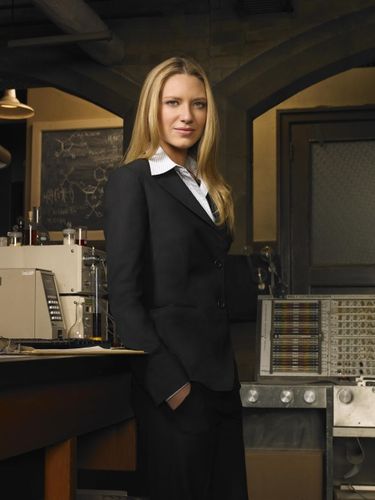
Throughout season one she is the main character. She is the centre of stories, and as the agent in charge, she is also boss of the cases they work. She’s the one to call the lab and tell them to get their gear and come investigate something gross. This changes a little in season two, and she is set up as something of a victim (recovering from a ‘car accident’), but this is changing. We are at about episode four, and she’s already back on her feet and kicking arse. Peter has taken on a more managerial role in the group, and the ‘Fringe division’ has officially been disbanded. Charlie has [SPOILER] died [/SPOILER], which sucks arse, but I’m dealing. So Olivia’s status has shifted. But this is ok, as Peter’s character has only slowly been working away from ‘carer’ for Walter and ‘general slacker’ towards some sort of three dimensional personhood. He’s also finally realising his abilities as an investigator type person. In other words, his character is gradually being fleshed out. I worry that he’ll become Olivia’s partner (in the sense of FBI ness and in the romantic sense), but I don’t see this happening any time soon.
I really like Olivia because I don’t worry about her. She’s kind of superhuman, but only in the way we expect our SF protagonists to be. She gets scraped and banged and shot occasionally, but it doesn’t stop her winning. Sure, she’s kind of a paragon of all things awesome, but this is as it should be in SF. She is, however, flawed. And [SPOILER] probably partly psychic and awesome because she was experimented on as a kid. But she has begun dealing with this history and is assimilating and coming to terms with its effects in a phenomenally healthy way. Which in itself is a bit worrying.
Olivia is an impossible woman. An impossible character. But this is as it should be in SF. This is how SF protagonists are: they are strong and brave and clever. Cleverness is important. She is conventionally attractive, but she doesn’t wear booby shirts or stupid shoes. She can run like a badass mofo and she likes suits. Just like the male agents around her. She wears her hair tied back in a piggy tail, or she wears a sensible black beanie. She doesn’t wear much make up. She is conventionally attractive. But so are most protagonists.
I <3 Olivia.
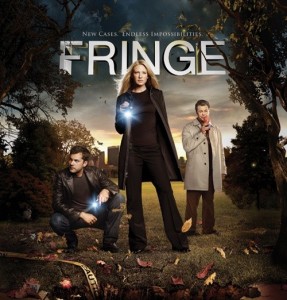
Olivia isn’t the only woman character in Fringe worth loving. I also love Astrid, who’s the agent assigned to working with Walter in his lab.
Astrid is also awesome.
She has a degree in cryptography, another in computer stuff (or is that a double major) and she’s got some sort of medical training (well, she does now). She loves cryptography. As in, she’s a nerd for it. And she loves computers.
She’s also an agent.
She calls Walter on his bullshit, including his inability to remember her name (which we suspect is a ploy on Walter’s part). She won’t let him (or anyone else) forget that she is actually a badass agent as well.
She deals with Walter’s gross dissections and experiments very matter of factly.

She runs errands and also has some badass ninja agent skills.
She veers into ‘servant territory’ every now and then, which is particularly worrying as she’s African American. But these little deviations are usually addressed: Astrid will call bullshit on Walter’s behaviour and regularly refuses tasks she feels cross the boundary from professional assistance to nurse maiding.
She is super smart.
She and Olivia talk regularly about things other than men. They often figure out puzzles together.

She is fond of Walter and also deals with his mental illness and fragile personality gently, yet without patronising him. She does not take on a carer role; she is, if nothing else, Walter’s lab assistant.
Nina Sharp is another important female character in Fringe. She’s the CEO of Massive Dynamic, a sort of super-corporation specialising in technology. A bit like Skynet Cyberdyne Systems, but awesomer. She admires Olivia greatly and has tried to recruit her to Massive Dynamic a number of times. She and Olivia have a refreshingly realistic relationship; they deal with each other as professionals. They do not have the sort of antagonistic rivalry alpha women are usually given in SF… in telly.They talk to each other about plenty of things besides men. They often talk about technology together. And science.
Nina Sharp is middle aged.
Nina Sharp has a bionic arm and a clear glass ipod thingy. She is way cool with technology generally. This is one middle aged woman who is not relegated to earth mother status; she is technology, economic and industrial power and smarts.
I love Olivia the most, though. I love the way she stops and thinks about things. I love the way she can fighty fight. I love it that though she might, one day be interested in Peter romantically, that day is waaaaaay off in the future, and for now she’s busy being a badass. He thinks she’s neat. He might think she’s neat in a romantic way, but for now he just thinks she’s a badass and he wants to be her partner, I think.
So I love Olivia Dunham. And this is why I can watch Fringe.
PS: I’ll try to add some more pics to this later, when I can figure out how to do it in this new version of MT without opening a new stupid window every time.
EDIT: I had to add this link to a drawing Jasika Nicole (the actor who plays Astrid) drew of herself.
recent emusicing
Jim Cullum Jazz Band Chasin’ the Blues. Just a few songs from this album, mostly because I’m a bit over this New Orleans revival sound. This album is really pretty freakin good, though. These are all live performances, and they rock. Their version of ‘Bugle Call Rag’ is lots of fun.
Each month I pick up a couple of songs from the Preservation Hall Jazz Band. This time from Shake That Thing. I like the shouty, live-ish feel of their stuff.
Bill Coleman in Paris 1936-1938. This isn’t something new. The recordings feature some top gun musicians: Stéphane Grappelli, Django Reinhardt, etc etc. I picked up this entire album.
Some Joe Liggins from the 1946-1948 Classics collection and the 1944-46 collection. This is solid jump/rhythm n blues stuff which I tend to put in the same category as Louis Jordan. Not exactly awesome lindy hopping action, but great fun nevertheless.
A couple of things from Celebrating Bix!. This has some pretty shit-hot musicians on it. I was following Vince Giordano around emusic and found this. More revival stuff.
The problem with this revival stuff is that it often lacks the fire of the originals – it’s technically pretty amazing, it’s clean, it’s crisp, but it can often feel a little sanitised. Too perfect.
midnight serenaders and janet klein
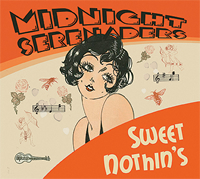 I am currently extremely nuts for the Portland band Midnight Serenaders‘ album Sweet Nothin’s (even though I’m unsure about that inverted comma in the title).
I am currently extremely nuts for the Portland band Midnight Serenaders‘ album Sweet Nothin’s (even though I’m unsure about that inverted comma in the title).
I bought the album from emusic this month and have been listening to it over and over. I played three songs from it at the after party I DJed on Saturday (though the first was to an empty room as I tested the sound gear): Swing Brother, Swing, Sweet Nothin’s and Who Walks in When I Walk Out?. They all went down a treat.
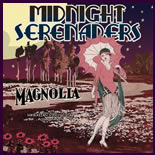 I really like this band: some of the musicians have bluegrass/jugband/ole timey roots, some jazz, and the steel guitarist used to be in Helmet. The female singer plays the ukelele, an instrument I have mixed feelings about. I’m not keen on the Aussie folky/community ukelele sound, but I do like it in an Hawaiian, jazznick context. I’m also fond of the way this band combines the ‘street jazz’ sound that’s very popular with some American dancers atm (a la the Loose Marbles, Cangalossi Cards, etc) with a more sophisticated studio mix. They also remind me of the Hot Club of Cowtown, which can only be an awesomely good thing.
I really like this band: some of the musicians have bluegrass/jugband/ole timey roots, some jazz, and the steel guitarist used to be in Helmet. The female singer plays the ukelele, an instrument I have mixed feelings about. I’m not keen on the Aussie folky/community ukelele sound, but I do like it in an Hawaiian, jazznick context. I’m also fond of the way this band combines the ‘street jazz’ sound that’s very popular with some American dancers atm (a la the Loose Marbles, Cangalossi Cards, etc) with a more sophisticated studio mix. They also remind me of the Hot Club of Cowtown, which can only be an awesomely good thing.
I haven’t bought their other album Magnolia, yet, but it’s only a matter of time.
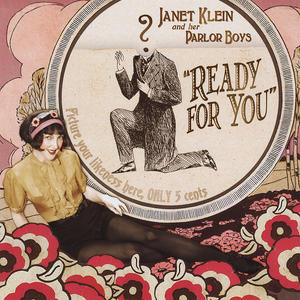
I’ve also just bought some songs from Janet Klein‘s second album Ready For You which has a similar style, but leans a little more heavily on the cutsey recreation of 20s girl singers. Klein has other albums, but I’m not so struck on the Paradise Wobble album on emusic, which is mostly vocals and ukele. I prefer Klein with the band balancing out the cutesy with some badass instrumental action.
I played That’s What You Think from Ready For You at that same after party, and it also went down a treat.
Though I have a feeling both these albums will work with dancers, I’m pretty sure the after party was kind of a loaded option: this was a crowd of post-ball dancers with a couple of drinks under their belts and a serious interest in part-aying. The presence of a few Melbourne dancers also reminded me of the seriously slow average tempos in Sydney – come on, gang, let’s get lindy hopping!
EDIT: I just bought Magnolia from the Midnight Serenaders, via CDBaby’s downloads. It was supercheap ($9.99 US/$11.92 AU) and supereasy… which isn’t a good thing for our bank account… The little I’ve heard of the album is fuuuully sick.
i love una mae carlisle
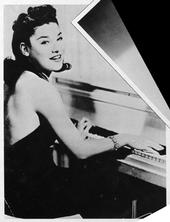 and I always have. One of my very first ‘jazz’ albums was a crappy compilation of ‘blues singers’ and it featured a version of Blitzkrieg Baby by Una Mae Carlisle. I like her attitude. I like her voice. I like it that in her duet with Fats on ‘I can’t Give You Anything But Love’ she gives as good as she gets from him. Checking out my emusic Chron Classics purchases in the discographies, I realised that she was playing with some seriously badass musicians, and that’s no doubt why her recording seriously rock.
and I always have. One of my very first ‘jazz’ albums was a crappy compilation of ‘blues singers’ and it featured a version of Blitzkrieg Baby by Una Mae Carlisle. I like her attitude. I like her voice. I like it that in her duet with Fats on ‘I can’t Give You Anything But Love’ she gives as good as she gets from him. Checking out my emusic Chron Classics purchases in the discographies, I realised that she was playing with some seriously badass musicians, and that’s no doubt why her recording seriously rock.
For those of you who’ve also bought stuff from emusic and don’t have details (liner notes! want!), I’ve added what I have below. Musicians to look out for: Fats (of course), Zutty Singleton, John Kirby, Lester Young, Buster Bailey, Charlie Shavers, Ray Nance… and more! No wonder these recordings rock the kasbah!
Don’t Try Your Jive On Me (05-20-38) Una Mae Carlisle with Dave Wilkins, Bertie King, Alan Ferguson, Len Harrison, Hymie Schneider 1938 2:52 Complete Jazz Series 1938 – 1941
I Would Do Anything For You (05-20-38) Una Mae Carlisle with Dave Wilkins, Bertie King, Alan Ferguson, Len Harrison, Hymie Schneider 1938 2:57 Complete Jazz Series 1938 – 1941
Hangover Blues (05-20-38) Una Mae Carlisle with Dave Wilkins, Bertie King, Alan Ferguson, Len Harrison, Hymie Schneider 1938 2:52 Complete Jazz Series 1938 – 1941
Love Walked In (05-20-38) Una Mae Carlisle with Dave Wilkins, Bertie King, Alan Ferguson, Len Harrison, Hymie Schneider 1938 2:38 Complete Jazz Series 1938 – 1941
Mean To Me (05-20-38) Una Mae Carlisle with Dave Wilkins, Bertie King, Alan Ferguson, Len Harrison, Hymie Schneider 1938 2:40 Complete Jazz Series 1938 – 1941
I’m Crazy ‘Bout My Baby (05-20-38) Una Mae Carlisle with Dave Wilkins, Bertie King, Alan Ferguson, Len Harrison, Hymie Schneider 1938 2:41 Complete Jazz Series 1938 – 1941
I Can’t Give You Anything But Love, Baby (11-03-39) Fats Waller and his Rhythm with Una Mae Carlisle 1939 2:57 Complete Jazz Series 1938 – 1941
Now I Lay Me Down To Dream (08-02-40) Una Mae Carlisle with John Hamilton, Albert Casey, Cedric Wallace, Slick Jones 1940 3:05 Complete Jazz Series 1938 – 1941
Papa’s In Bed With His Britches On (08-02-40) Una Mae Carlisle with John Hamilton, Albert Casey, Cedric Wallace, Slick Jones 1940 2:42 Complete Jazz Series 1938 – 1941
If I Had You (08-02-40) Una Mae Carlisle with John Hamilton, Albert Casey, Cedric Wallace, Slick Jones 1940 3:27 Complete Jazz Series 1938 – 1941
You Made Me Love You (08-02-40) Una Mae Carlisle with John Hamilton, Albert Casey, Cedric Wallace, Slick Jones 1940 2:55 Complete Jazz Series 1938 – 1941
Walkin’ By The River (11-03-40) Una Mae Carlisle with Benny Carter, Everett Barksdale, Slam Stewart, Zutty Singleton 1940 3:05 Complete Jazz Series 1938 – 1941
I Met You Then, I Know You Now (11-03-40) Una Mae Carlisle with Benny Carter, Everett Barksdale, Slam Stewart, Zutty Singleton 1940 2:53 Complete Jazz Series 1938 – 1941
Blitzkrieg Baby (03-10-41) Una Mae Carlisle with Shad Collins, Lester Young, Clyde Hart, John Collins, Nick Fenton, Hal West 1941 3:22 Complete Jazz Series 1938 – 1941
Beautiful Eyes (03-10-41) Una Mae Carlisle with Shad Collins, Lester Young, Clyde Hart, John Collins, Nick Fenton, Hal West 1941 3:04 Complete Jazz Series 1938 – 1941
They’ll Be Some Changes Made (03-10-41) Una Mae Carlisle with Shad Collins, Lester Young, Clyde Hart, John Collins, Nick Fenton, Hal West 1941 2:45 Complete Jazz Series 1938 – 1941
It’s Sad But True (03-10-41) Una Mae Carlisle with Shad Collins, Lester Young, Clyde Hart, John Collins, Nick Fenton, Hal West 1941 3:31 Complete Jazz Series 1938 – 1941
I See A Million People (05-01-41) Una Mae Carlisle with Charlie Shavers, Buster Bailey, Russell Procope, Billy Kyle, John Kirby, O’Neil Spencer 1941 3:04 Complete Jazz Series 1938 – 1941
Oh I’m Evil (05-01-41) Una Mae Carlisle with Charlie Shavers, Buster Bailey, Russell Procope, Billy Kyle, John Kirby, O’Neil Spencer 1941 2:25 Complete Jazz Series 1938 – 1941
You Mean So Much To Me (05-01-41) Una Mae Carlisle with Charlie Shavers, Buster Bailey, Russell Procope, Billy Kyle, John Kirby, O’Neil Spencer 1941 2:51 Complete Jazz Series 1938 – 1941
The Booglie Wooglie Piggy (05-01-41) Una Mae Carlisle with Charlie Shavers, Buster Bailey, Russell Procope, Billy Kyle, John Kirby, O’Neil Spencer 1941 2:42 Complete Jazz Series 1938 – 1941
Don’t Tetch It! (02-13-42) Una Mae Carlisle with Charlie Shavers, Buster Bailey, Russell Procope, Billy Kyle, John Kirby, O’Neil Spencer 1942 2:21 Complete Jazz Series 1941 – 1944
So Long, Shorty (02-13-42) Una Mae Carlisle with Charlie Shavers, Buster Bailey, Russell Procope, Billy Kyle, John Kirby, O’Neil Spencer 1942 2:30 Complete Jazz Series 1941 – 1944
Tain’t Yours (05-23-44) Una Mae Carlisle with Ray Nance, Budd Johnson, Snags Allen, Bass Robinson, Shadow Wilson 1944 2:53 Complete Jazz Series 1941 – 1944
I’m A Good, Good, Woman (05-23-44) Una Mae Carlisle with Ray Nance, Budd Johnson, Snags Allen, Bass Robinson, Shadow Wilson 1944 2:50 Complete Jazz Series 1941 – 1944
I Like It, ‘Cause I Love You (05-23-44) Una Mae Carlisle with Ray Nance, Budd Johnson, Snags Allen, Bass Robinson, Shadow Wilson 1944 3:06 Complete Jazz Series 1941 – 1944
even more recent emusic adventures
Here, Trev – this is what I’ve been downloading from emusic lately.
Btw everyone else, if you’re at all interested, then you can find me on emusic as dogpossum and check out exactly what I’ve been downloading.
Someone recommended Duke Heitger’s Krazy Kapers on HeyMrJesse recently, and while I’ll definitely pick that up at some point (you really should try JBM if you haven’t – fabulous (really fabulous) range of music, delivered old-school, by snailmail), I went straight to emusic to see if I could get some instant satisfaction.

I found Rhythm Is Our Business by Duke Heitger And His Swing Band . Isn’t that a scary here-comes-some-second-rate-neo! cover? But the album is actually quite good. I downloaded just one song – ‘Murder he says’ – because it’s a strangely addictive version. I plan on DJing that tonight.
Here’s the Betty Hutton version:
There is a Tori Amos version (from that crappy film ‘Mona Lisa Smiles’) but I wouldn’t recommend it. In fact, it’s the sort of shit you hear the odd DJ play at swing events. For which they will go to DJing hell.
At any rate, I’m into Duke Heitger, and will chase up more of his stuff. Basically, he’s a badass trumpeter who’s doing recreationist swing. That album is really quite good. As good (if not better) than people like the Campus Five.
 He also has another album on emusic, The Rosehill Concerts. I prefer this one – the energy’s a little hotter, and it’s a live recording, which always lends itself to funner, higher energy… well, nearly always. I’ve downloaded a few good songs for blues dancing and a really nice version of ‘Christopher Columbus’, but I’m going to see how the 12-song deal on emusic goes. This album does rock, but many of the songs are quite long, which can be a bit of a challenge for DJing, especially when the tempos are higher.
He also has another album on emusic, The Rosehill Concerts. I prefer this one – the energy’s a little hotter, and it’s a live recording, which always lends itself to funner, higher energy… well, nearly always. I’ve downloaded a few good songs for blues dancing and a really nice version of ‘Christopher Columbus’, but I’m going to see how the 12-song deal on emusic goes. This album does rock, but many of the songs are quite long, which can be a bit of a challenge for DJing, especially when the tempos are higher.
So, Duke Heitger = good find. Thanks that guy on HeyMrJesse (I think it was Marcello, but I’m not sure).

I’ve also downloaded about a million versions of ‘On Revival Day’, because it’s a truly fabulous song. Searching for these, I came across a bloke called Bob Howard. I picked a few songs from his 1937-1947 Chronological Classic. He sounds a bit like Fats Waller, but a little straighter and not quite as good.
The best version is the Bessie Smith one. She is the freakin’ shizzle.

But I have a Jimmie Noone version I quite like from The Complete Recordings vol2 disc 3. This isn’t the most amazing music in the world, but I really like Noone – I love his playing style. This one is 279bpm and a little too rough for DJing too often. The Bob Howard is a bit slower and a bit better.
 Another version I picked up is by Carrie Smith from When You’re Down and Out (a Definitive Black and Blue). This is a little closer to the overplayed Lavern Baker version (from the Bessie Smith tribute album), but it’s a bit faster. I like Carrie Smith – she has a big, shouting voice. This version has the irresistible handclaps that make you want to dance like a fool. I also downloaded ‘Nobody wants you when you’re down and out’ from that album for blues dancing. It’s nice. Smith has a lovely voice and a really nice style. Reminds me a bit of Alberta Hunter, but her voice isn’t as damaged and she doesn’t mug quite as much (which is a bit of a relief – Hunter can get a bit much sometimes).
Another version I picked up is by Carrie Smith from When You’re Down and Out (a Definitive Black and Blue). This is a little closer to the overplayed Lavern Baker version (from the Bessie Smith tribute album), but it’s a bit faster. I like Carrie Smith – she has a big, shouting voice. This version has the irresistible handclaps that make you want to dance like a fool. I also downloaded ‘Nobody wants you when you’re down and out’ from that album for blues dancing. It’s nice. Smith has a lovely voice and a really nice style. Reminds me a bit of Alberta Hunter, but her voice isn’t as damaged and she doesn’t mug quite as much (which is a bit of a relief – Hunter can get a bit much sometimes).
What was with my interest in ‘Revival Day’? Well, I’ve taken to playing it after ‘Lavender Coffin’ sometimes when I’m DJing. It’s not the best stylistic transition, but I like the whole ‘jeeeeezus!’ vibe. I usually play the Lavern Baker one, but it’s a bit annoying and overplayed. I will move to the Carrie Smith one. Or the Bessie Smith, depending on the crowd and the vibe. Bessie Smith’s is really the very best – she has the biggest, baddest badass voice.
 And, finally, I got a bunch of stuffs from The Sidney Bechet Society Jam Session Concert album. Mostly things for blues dancing, though. This was another one I found via HeyMrJesse.
And, finally, I got a bunch of stuffs from The Sidney Bechet Society Jam Session Concert album. Mostly things for blues dancing, though. This was another one I found via HeyMrJesse.
The wonderful thing about the latest HeyMrJesse show (June 2009) was that it featured bands from the recent Frankie95 weekend. Are we drooling, much? YES! Jesse is (as per usual) a bit heavy on the groovier, shufflier sound, but then, that’s his cup of tea. There is some really lovely action in there, though, so have a peek. A trumpet solo on the version of ‘Basin Street Blues’ on the Bechet Society album just moved The Squeeze to a sort of frenzied loungeroom thrash-dance, so it has to be good.
EDIT: I have to add this one other album I discovered. I’d heard early Louis Prima was quite hot and good, but this was the first I’d actually sampled:

Louis Prima volume 1. I only grabbed a couple of songs, but I did get a sweet, uptempo vocal version of ‘Chasing Shadows’. I also grabbed ‘Swing Me With a Rhythm’, but I might go back for more, because it’s nice. Not the best music in the world, but fun.
wingy manone
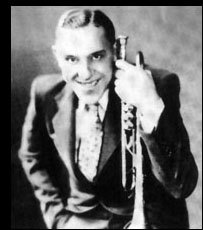
I’ve been downloading a bunch of Wingy Manone from emusic’s Chron Classics/Complete Jazz collection. I thought I could keep away from him, but I can’t. He played the trumpet in bands with all sorts of people in New Orleans, Chicago and New York.
This Redhotjazz.com entry states:
Wingy Manone was a New Orleans trumpet player and vocalist who lost his right arm in a streetcar accident when he was ten years old. He wore a prosthetic arm while on stage performing and used it so well that many never noticed his disability.
Makes me wonder if they realise that it’s not a disability if it’s not impairing his abilities…
Marty Grosz and his Honoris Causa Jazz Band, Hooray for Bix!

Marty Grosz and his Honoris Causa Jazz Band, Hooray for Bix! Despite the scary album cover (this was released in 1957), there’s some nice stuff on this album. I’m getting a bit tired of New Orleans revival bands (especially the ones from the 50s and later), but Marty Grosz is a guitarist, and this is reflected in the music – there’s a little less emphasis on the brass. Well, comparatively speaking. I’m still not liking the shuffle rhythm from the drummer on some tracks (it’s just NOT RIGHT for NO stuff), but there are a couple of songs I really quite like and will play for dancers. In an ideal world I’d stick to the originals, but some of those originals are really scratchy.
In an interesting turn of events, emusic is now releasing the Chronological Classics albums as well as the ‘Complete Jazz Series’ albums, though they seem to be the same albums. I’m not sure whether there’s a sound quality difference, but even CC wasn’t perfect sound quality – it’s more for people who’re looking to collect everything from an artist during a particular year. Which you can do with these series.
recent emusic adventures
My emusic account ticks over on the 19th, and I’ve managed to hang onto some of my downloads til today… and there are still some left! It’s too easy to use them up, though, especially when you’re an ob-con tempted with the option of ‘going complete’ with an achievable artist… such as Jimmie Noone or the McKinney’s Cotton Pickers. But I find I really can’t absorb much more than my download limit per month. Well, not if I also want to keep listening to my existing collection and knowing it well enough to DJ with any sort of competence.
But this is what I’ve downloaded recently:

Lavern Baker Sings Bessie Smith. Just a few songs. I had a couple of tracks from this already from compilations, but I noticed it’d been added to emusic lately (that ‘music you might like’ thingy is very convincing) and figured I’d download a few things. Namely ‘Gimme a Pigfoot’. I’ve just come across a really slinky Billie Holiday version and thought I’d like the Baker one. And I do. She’s no Bessie Smith, but she don’t suck. There are moments, though, when I wish Baker’d follow through on her big, arse-kicking intros; she tends to back off a bit a few bars in. Bessie wouldn’t.

Duke Ellington and His Famous Orchestra 1941: The Complete Standard Transcriptions. Just a couple from here, but versions I didn’t have. I’ve really enjoyed a few tracks from the Bob Crosby album in this series, and thought I’d give these a punt. Nice. No surprises, but slightly better quality than some versions of these I already have, and ‘John Hardy’ is a bit quicker (and snappier) than the one I had. Transcripts are interesting because they were recorded for the radio, some of them live. Digging through the discographies has made me realise just how important broadcast radio was to jazz and to music in the early days. Live broadcasts were de rigeur, and important to musicians’ careers.
Jimmie Noone, Wingy Manone, Doc Cook and His 14 Doctors Of Syncopation, Andy Kirk and other scratchies. Mostly obsessing over these doods.
But I can never go past a little hifi or good quality saucy blues.

Big Mama Thornton’s ‘Ball n Chain’. Just the song ‘Gimme a Penny’. Because that’s all you need, really. Well, that and ‘Hound Dog’, because some skinny-arse white boy ain’t got nothin’ on this sister.
The Bluesville Years Volume 11: Blues Is A Heart’s Sorrow (you don’t need a photo for this one). I’ve downloaded various bits and pieces in this series. The quality is fab. The artists are amazing. The songs are super, excellently saucy. Not at all G-rated.
There are lots more, but this is the sort of thing I’m enjoying at the moment. Gotta go eat pizza now. :D
billie holiday and louis armstrong
This is a nice clip of Louis Armstrong (and amazing band) playing ‘Dixie Music Man’ from the 1947 film New Orleans.
The woman with the flowers in her hair is Billie Holiday. The band features Kid Ory, Bunny Berigan and Zutty Singleton (with others) – musicians I’ve been following through a range of bands lately.
This clip was posted by Rayned on faceplant, and it’s timely because I’m obsessed by Armstrong and Holiday at the moment. Yesterday I photocopied all the bits of the Discography referring to Holiday. I’m not going to even try that with Armstrong – there’s an entire, huge book devoted to his recordings alone.
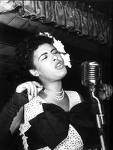 It’s fascinating to follow these guys through different bands. Both were really amazing musicians with a sense of swing that’s really incomparable. You can pick Armstrong’s trumpet in any recording, no matter how crappy and crackly. and Billie… her later stuff is really tricky to dance to because she’s so clever with phrasing and timing. Sometimes she’s so way, way back there behind the beat you’re sure she’s just about to be out of time completely. I like listening to the way she shapes a band when she’s singing with them – with live recordings. She can work around a straight, uptight band and make them sound like they’re actually hot. Same goes for Louis – these guys have a sense of timing that’s impeccable. Like really good comedians.
It’s fascinating to follow these guys through different bands. Both were really amazing musicians with a sense of swing that’s really incomparable. You can pick Armstrong’s trumpet in any recording, no matter how crappy and crackly. and Billie… her later stuff is really tricky to dance to because she’s so clever with phrasing and timing. Sometimes she’s so way, way back there behind the beat you’re sure she’s just about to be out of time completely. I like listening to the way she shapes a band when she’s singing with them – with live recordings. She can work around a straight, uptight band and make them sound like they’re actually hot. Same goes for Louis – these guys have a sense of timing that’s impeccable. Like really good comedians.
(‘Fireworks’, Louis Armstrong & His Hot 5 with Earl Hines, Zutty Singleton 1928)
For my money, Armstrong was really rocking with this small groups in the late 20s. This was a collection of great New Orleans jazz musicians, many of whom began with King Oliver, and most of whom moved on to Chicago and then New York (and further afield). I’m a massive fan of Kid Ory, but I’m also digging Zutty Singleton. I’m a bit of a nut for rhythm sections generally (I think it’s because I listen to this stuff as a dancer), and Singleton just keeps popping up in the bands I like.
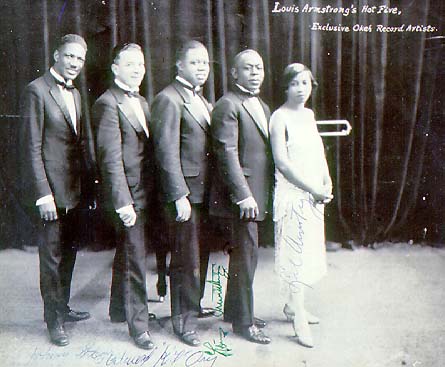
(That pic of the Armstrong Hot Five is from the Louisiana State Museum site, which is just fascinating.)
I was a little sceptical of the claims made about Armstrong’s Hot fives and sevens until I actually sat down and listened to them in chronological order – after the stuff he did supporting singers like Bessie Smith (! powerhouse combo, much? An example: St Louis Blues 1925)), after his work with King Oliver. But before his Orchestra stuff of the 1930s (some of which is a bit dodgy, I’ve found). I’m not really interested in his stuff after the 50s (though I bet I’ll change my mind on that too), and I really don’t like ‘Hello Dolly’ and all that vocal rot. I quite like him doing nice, silky groovy duets with Ella Fitzgerald (many of which included Oscar Peterson), but my real interest in his music is in his late 20s and early 30s stuff when you really hear his approach to timing and nuance signaling musical change: the swing era’s coming. But nobody else is really there yet.
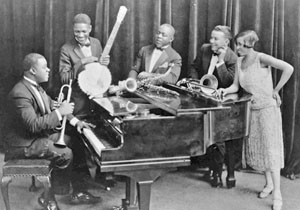
(That pic of the Hot five to the right is from this interesting blog)
These Hot Five and Seven bands were really one of the the first real opportunities for Armstrong to experiment with music and musicians on his own terms in his own bands. I think the smaller group allows the sort of group or ensemble improvisation that you just can’t keep under control with a big band. The best example of this sort of improvisation usually comes in the final chorus when it sounds as though everyone’s doing their own thing (because they are), but are still working together, playing within a particular framework. That’s the sort of thing I LOVE as a dancer and DJ because it reminds me of lindy hop – improvisation within structure. I love playing this sort of stuff for dancers because the energy suddenly leaps in that final chorus, and you can end a song (or a set) on a high energy point. I especially love Fats Waller for this. He might begin with a quieter song whose clever lyrics make you listen up carefully, but he ends with a loud, raucous shouting chorus that makes you bust out like a fool on the dance floor.
In a smaller group, Armstrong lets the musicians play in their own ways, but still works as the lynchpin in a fairly complicated musical machine. The ensemble improvisation allows each musician to shine with improvisation, but still maintains a sense of group or collaborative wholeness; it’s not just random noise. The musicians were all amazing, including Louis Armstrong on trumpet, Lil Hardin (who became Lil Hardin Armstrong) on piano, Johnny Dodds on clarinet, Kid Ory on trombone and Johnny St. Cyr on banjo. The band’s membership changed a little, and the group also recorded as the Hot Seven (there are a range of other names for similar groupings, including a special Savoy small band). Additional musicians included Kid Ory (cornet), Lonnie johnson (guitar), Earl Hines (piano), Zutty Singleton (drums) and a few different vocalists (May Alix is one who catches my eye because she also did work with Jimmie Noone, who I love). The Hot Fives and Sevens recorded between 1925 and 1928 (you can read more about the Hot 5 here on redhotjazz.com).
Just in case you’re wondering where the Billie Holiday talk is…
I really like this recording of ‘Fine and Mellow’. The musicians are, of course, amazing. It’s from 1957, when Billie was already more than a little trashed by drugs and alcohol. But she really was a phenomenal singer. Even as her voice became more and more ragged, her technique and sense of music were indefatigable. The Decca collection liner notes mention that she was the sort of musician (or artist is the term I think they use) who used one or two takes to record songs. She could simply get it right the first time. As the liner notes say, she had an idea of how she was going to do the song, and then she did it. Holiday didn’t have the length of career that Armstrong did (he was recording from 1923 (at least) til 1971), she had only a couple of decades), but her music spread from that hot, swinging jazz moment in the 30s and the pop/ballad/jazz feel of the 50s and 60s.
And of course, I’ve just written a post which presents the history of ‘jazz’ in terms of two ‘artists’. But I think it’s important to note that Armstrong’s Hot Five were just that – five (or seven, or six) musicians working together. The collective improvisation is really important, this isn’t the showcasing of solos of the swing era. This is a group of people working and listening together to make something together. Holiday’s work as a vocalist was primarily as a response to the bands and musicians she was working with. Her close friendship with Lester Young is perhaps the best example. There’s plenty of anecdotal (and evidence based) discussion of their musical collaboration as a process of listening to and learning from each other. Young is often quoted as being most inspired by vocalist’s technique. Holiday is often referred to as emulating Young’s saxophone technique. Their musical relationship was indubitably one of collaboration and mutual inspiration. After all, it’s very difficult to be a jazz musician all on your own.
